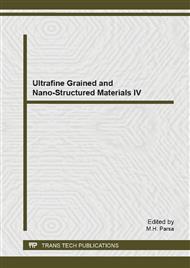[1]
S. M. Park, J. S. Yoo, electrochemical impedance spectroscopy for better electrochemical measurements, Anal. Chem, 75 (2003) 455 A-461 A.
DOI: 10.1021/ac0313973
Google Scholar
[2]
A. Lasia, Electrochemical impedance spectroscopy and its applications, in: Modern aspects of electrochemistry, Springer, 2002, pp.143-248.
DOI: 10.1007/0-306-46916-2_2
Google Scholar
[3]
E. Barsoukov, J.R. Macdonald, Impedance spectroscopy: theory, experiment, and applications, Wiley-Interscience, (2005).
Google Scholar
[4]
M.E. Orazem, B. Tribollet, Electrochemical impedance spectroscopy, Wiley-Interscience, (2011).
Google Scholar
[5]
J. Hitzig, K. Jüttner, W. Lorenz, W. Paatsch, Corrosion science, 24 (1984) 945-952.
DOI: 10.1016/0010-938x(84)90115-x
Google Scholar
[6]
F. Debuyck, L. Lemaitre, M. Moors, A. Van Peteghem, E. Wettinck, L. Weyten, Surface and coatings technology, 34 (1988) 311-318.
DOI: 10.1016/0257-8972(88)90121-1
Google Scholar
[7]
H. J. Oh, K. W. Jang, C. S. Chi, Impedance characteristics of oxide layers on aluminium Bull. Korean Chem. Soc, 20 (1999) 1341.
Google Scholar
[8]
A. Foyet, A. Hauser, W. Schäfer, Double template electrochemical deposition and characterization of NiCo and NiCu alloys nanoparticles and nanofilms, J. Solid State Electrochem., 12 (2008) 47-55.
DOI: 10.1007/s10008-007-0332-2
Google Scholar
[9]
P. C. Chen, Y. M. Chang, P. W. Wu, Y. F. Chiu, Fabrication of Ni nanowires for hydrogen evolution reaction in a neutral electrolyte, Int. J. Hydrogen Energy , 34 (2009) 6596-6602.
DOI: 10.1016/j.ijhydene.2009.05.126
Google Scholar
[10]
B. Benfedda, L. Hamadou, N. Benbrahim, A. Kadri, E. Chainet, F. Charlot, Electrochemical Impedance Investigation of Anodic Alumina Barrier Layer, J. Electrochem. Soc., 159 (2012) C372-C381.
DOI: 10.1149/2.068208jes
Google Scholar
[11]
Y. Huang, H. Okumura, G. Hadjipanayis, D. Weller, CoPt and FePt nanowires by electrodeposition, J. Appl. Phys., 91 (2002) 6869-6871.
DOI: 10.1063/1.1447524
Google Scholar
[12]
S. Chu, S. Inoue, K. Wada, K. Kurashima, Fabrication of integrated arrays of ultrahigh density magnetic nanowires on glass by anodization and electrodeposition, Electrochim. Acta, 51 (2005) 820-826.
DOI: 10.1016/j.electacta.2005.03.075
Google Scholar
[13]
S. Ichihara, M. Ueda, T. Den, Electrodeposition of FePt magnetic material and embedding into alumina-nanoholes, IEEE Trans. Magn., 41 (2005) 3349-3351.
DOI: 10.1109/tmag.2005.854704
Google Scholar
[14]
Y. Pang, B. Zhang, J. Zhao, J. Wang, Y. Wu, Synthesis and magnetic properties of FePt- Fe3Pt nanowire arrays embedded in anodic alumina membranes, Integr. Ferroelectrics., 135 (2012) 77-81.
DOI: 10.1080/10584587.2012.685406
Google Scholar
[15]
F. Li, L. Ren, Fabrication and magnetic properties of FePt3 nanowire arrays, phys. status solidi (a), 193 (2002) 196-201.
DOI: 10.1002/1521-396x(200209)193:1<196::aid-pssa196>3.0.co;2-1
Google Scholar
[16]
J. H. Gao, Q. F. Zhan, W. He, D. L. Sun, Z. H. Cheng, Synthesis and magnetic properties of Fe3Pt nanowire arrays fabricated by electrodeposition, Appl. Phys. Lett., 86 (2005) 232506-232506-232503.
DOI: 10.1063/1.1944210
Google Scholar
[17]
H. Wang, Y.C. Wu, L. Zhang, X. Hu, Fabrication and magnetic properties of FePt multilayered nanowires, Appl. Phys. Lett., 89 (2006) 232508-232508-232503.
DOI: 10.1063/1.2402888
Google Scholar
[18]
J. Xu, Z. Zhang, B. Ma, Q. Jin, Compositional control of FexPt(1-x) nanowires by electrodeposition. J. Appl. phys., 109 (2011) 07B704-707B704-703.
Google Scholar


